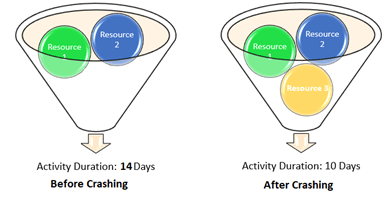Schedule Compression Techniques – Fast Tracking vs Crashing
Fast Tracking and Crashing are schedule compression techniques which are applied during develop schedule process to shorten an already developed schedule. The purpose of using schedule compression techniques is to try to compress the schedule (shorten the project duration) without changing the original project scope . If the project scope is not changed and the project falls behind the schedule, the only way is to compress the remaining schedule in order to catch up the project schedule. This article discusses the schedule compression techniques by focusing on the fast-tracking vs crashing concept.
Table of Contents
What are Schedule Compression Techniques ?
Most of the projects are behind the schedule and/or over budget. Project managers and project teams seek the ways of catching the project schedule and complete the project on time. They use numerous methods and techniques for this purpose to meet the client’s requirements. However, they are not successful in most cases because delays in the critical path trigger project delays.
There are many schedule compression techniques used to reduce the project duration without changing the project scope. Common schedule compression techniques are crashing, fast tracking and resource reallocation.
Simply put, these techniques can be used when a project;
- Falls behind the project schedule
- Needs to accelerate
- Needs to finish earlier than originally planned
Fast Tracking vs Crashing
In a project, delays may occur due to some reasons such as unforeseen events, unrealistic assumptions, weather conditions, mismanagement, insufficient resource management etc. One reason to apply the schedule compression techniques is to mitigate the delays and catch up the project schedule.
Another reason is that sometimes project stakeholders may deliberately compress the schedule. Because they may expect cost benefit or bonus for completing earlier. Therefore they need some techniques to complete the project earlier. Fast tracking and crashing are the most widely used schedule compression techniques in project management.
What is Fast Tracking ?
As per the PMBOK Guide, Fast Tracking is a schedule compression technique in which activities or phases are normally done in sequence are performed in parallel for at least a portion of their duration.
Below figures illustrate two activities of a schedule. Activity A is the predecessor of Activity B. On the left side, there is a Finish to Start relationship between them and the Activity B will start after the completion of Activity A. Total duration is 10 Days.
Schedule Compression – Fast-Tracking
Then the project team decided to apply fast tracking method. Figure on the right side demonstrates the result after fast tracking. There is an overlap for 3 days between the Activity A and Activity B. Total duration is now 7 Days.
In the Fast Tracking technique, the first step is to analyze the critical path and determine the activities which are on the critical path or near the critical path because, on other paths, activities have floats.
After analyzing the critical path, network logic should be changed in order to perform the activities in parallel instead of series. While applying this technique, the applier must be careful. Because if two activities are depending on each other by nature, they can not be performed in parallel. For example, you can not strike formwork before concrete pouring.
Also, you should keep in mind that changed network logic causes additional risks to your project.
Simply put, fast tracking technique does not involve an additional cost. It is related to changing the sequence of the activities and logic of the project schedule. Therefore it can be the first technique to be considered for this purpose.
What is Crashing ?
As per the PMBOK Guide, Crashing is a technique used to shorten the schedule duration for the least incremental cost by adding resources.

Schedule Compression – Crashing
In the crashing technique, in order to catch up the project schedule, extra resources should be put on the remaining activities. Because if it is possible to assign more resources, activity duration will decrease and this will shorten the duration of the critical path. But you should keep in mind that extra resources cause additional costs to your project. You need to calculate the value of schedule compression techniques before to decide to use.
Which Schedule Compression Technique Will You Use ?
Project schedules and execution strategies change as the projects progress. The project schedules do not reflect the real conditions unless they are updated regularly. Before to decide which schedule compression technique to use, make a detailed critical path analysis . For that reason, the critical path of the project must be realistic. Because if you apply the schedule compression techniques to the activities which are not on the critical path, you can not shorten the project duration.
Fast tracking seeks to complete the project earlier by performing the activities simultaneously. This increases risks and may cause lack of coordination between the parties.
Crashing aims to shorten the project duration by increasing labor, equipment, subcontractor and other resources. This technique costs extra money.
Summary
Depending on the situation and requirements of your project, you can select one of this schedule compression technique. In some cases, you have to use both of them to catch up the schedule. Fast tracking does not include additional cost but it increases risks. Because changes in the project schedule necessitate additional coordination between the project team and the subcontractors. On the other hand, crashing does not increase risk but it increases costs. Bringing additional resources increases production and transportation costs. Please note that this topic is very important for the PMP Certification Exam. There may be some questions related with fast tracking vs crashing.
External References
[1] pmi.org

Irma Gilda is chief executive of Sonic Training and Consultancy Co., the training platform offers project planning and scheduling More than 60 k learners have used the platform to attain professional success. Irma is a professional Primavera P6 Trainer.











It shold be “In Crashing technique” instead of “In Fast Tracking technique” under relevant picture